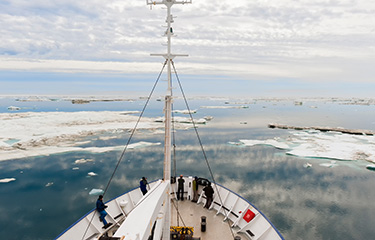The U.S. and Russia are each moving to investigate opening up commercial fisheries in the Arctic, following fish stocks that have shifted northward due to climate change.
Currently, there is a ban on fishing in the Arctic, after nine nations and the European Union signed the Central Arctic Ocean Fisheries Agreement – officially known as Agreement to Prevent Unregulated High Seas Fisheries in the Central Arctic Ocean – in 2018. After ratification, the agreement went into effect on 25 June, 2021 and bans fishing in the Central Arctic until at least 2037. The treaty limits fishing in the high seas area of the Arctic to research trips only and can be extended in five-year increments by unanimous consent.
Additionally, in 2009, the U.S. government introduced the Arctic Fishery Management Plan, which, after it was approved by the North Pacific Fishery Management Council, closed 150,000 square nautical miles of state waters in Alaska to fishing north of the Bering Strait, including the Chukchi and Beaufort seas.
In Russian-controlled waters in the Chukchi Sea, a commercial pollock fishery opened in 2020, and Pacific cod has also moved into the area due to mass migration of stocks to cooler waters known as “borealization.”
But the U.S. and Russia are still adhering to the Central Arctic Ocean Fisheries Agreement, with officials from both countries meeting in Utqiagvik, Alaska in March 2023 to develop at a joint science plan.
“There are still big challenges, but there will not be commercial fisheries in this area for at least the life of the agreement, which is 16 years,” David Balton, a former U.S. State Department diplomat who helped negotiate the agreement, said at the Arctic Encounter Symposium in Anchorage, Alaska on 29 March, according to the Alaska Beacon.
Balton, who now serves as executive director of the White House’s Arctic Executive Steering Committee, praised the parties to the agreement for adhering to the treaty.
“It’s quite a success story,” he said.
Also speaking at the symposium was Alaska Department of Fish and Game Commissioner Doug Vincent-Lang, who said he is leading his agency to prepare for the end of the moratorium on commercial fishing in the state’s Arctic waters. He is seeking USD 1 million (EUR 916,000) in funding from the state of Alaska and USD 2 million (EUR 1.8 million) in federal funds to research the issue.
“We see opportunities for our coastal communities to develop fisheries. And we certainly don’t want to be left onshore while Russia and other countries go out and fish those waters,” he said.
Vincent-Lang said if the funding is approved, he will prioritize research to identify biomasses and stocks north of the Bering Strait that have the ability to be developed into commercial fisheries. AFDG will also formulate a system for determining fishery participants, including allocating shares to Arctic communities.
“We also need to get started on what a fishery management [system] looks like,” he said. “We’re starting to think through those processes. We’re starting to do that work.”
Photo courtesy of GTW/Shutterstock







